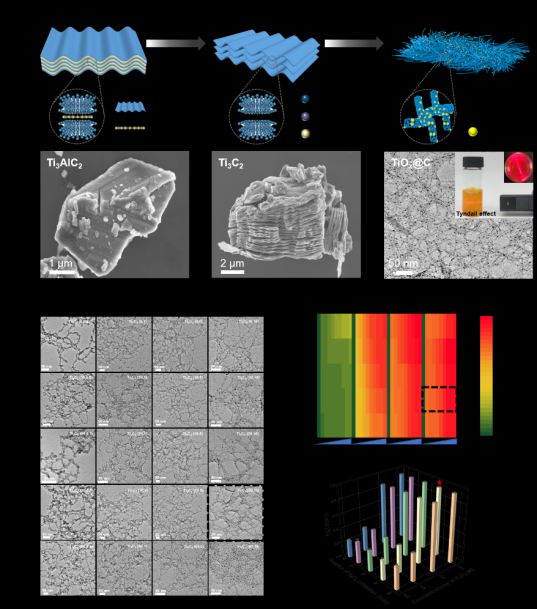Recently, Professor LIN Sijie's team published online a paper entitled “In situ turning defects of exfoliated Ti3C2 MXene into Fenton-like catalytic active sitese" in Proceedings of the National Academy of Sciences of the United States of America (PNAS).
In this study, a new strategy for in situ construction of Fenton-like nanocomposite catalysts is proposed, which utilizes MXene intrinsic surface defects and abundant transition metal precursors. In this paper, a series of amorphous carbon-supported high-density TiO1.47 nanoclusters (TiO1.47 @ C) were prepared with delaminated Ti3C2 MXene as templates, which revealed the reaction of atrazine degradation by H2O2 activated by titanium-based Fenton-like catalyst. The research demonstrated the realization of two-dimensional nanomaterials "Safer-by-design", which provided a new strategy for efficient treatment of endocrine disruptors and antibiotics.

A new strategy for in situ construction of Fenton-like nanocomposite catalysts using MXene intrinsic surface defects and abundant transition metal precursors was proposed.
A new wet oxidation process of H2O2 was developed. With Ti3C2-MXene as the template, the intrinsic Ti defects formed in the etching process react strongly with H2O2, and the high density TiO1.47 nanoclusters supported on amorphous carbon (TiO1.47 @ C) are formed in situ. The optimum preparation conditions (10 mol·L-1 H2O2, 30 min) were selected by changing the concentration of H2O2 and the reaction time; and the maximum sample yield (> 97%) was achieved at the same time. The Ti defects on the surface of Ti3C2 MXene are proved to be the key reactive sites for the formation of TiO1.47 nanoclusters by DFT calculations. The nanoclusters are abundant in surface defects and the coexistence of Ti multivalent states (the average valence state is +2.94) exists in the system. Based on X-ray absorption fine structure spectroscopy (EXAFS) analysis. It is concluded that the fracture of Ti-C-Ti bond and the formation of Ti-O bond caused by H2O2 in situ oxidation during the synthesis process are the key to the in situ synthesis of the nanoclusters. A variety of typical new pollutants (such as atrazine, tetracycline and p-nitrophenol) were efficiently degraded by highly activating H2O2 through the valence change of Ti element.
This approach is universal, and therefore applicable to other MXene family matertials, including V2C, Nb2C. The study broadens the potential application of MXene family materials, catalyzes the in-situ synthesis of nanoclusters with high activity, and realizes the composite anchoring of nanoclusters on carbon substrates, thus effectively reducing the potential environmental risks caused by material leakage.
Professor LIN Sijie is the correspondent author of this paper, and JIANG Yue, a postdoctoral research fellow from the College of Environmental Science and Engineering, is the only first author. The authors are grateful to the help from Professor LIANG Shixian of Hong Kong Baptist University, associate researcher WANG Liming of Institute of High Energy Physics of Chinese Academy of Sciences, Professor SHENG Wenchao of Tongji University, Dr.JIN Shan of Suzhou Institute of Nanotechnology and Nanobionics of Chinese Academy of Sciences and BL14W1 Line Station of Shanghai Synchrotron Radiation Source. The research was supported by the National Natural Science Foundation of China, the National Key R&D Plan and the Special Funds for Basic Scientific Research.
Paper link: https://doi.org/10.1073/pnas.2210211120